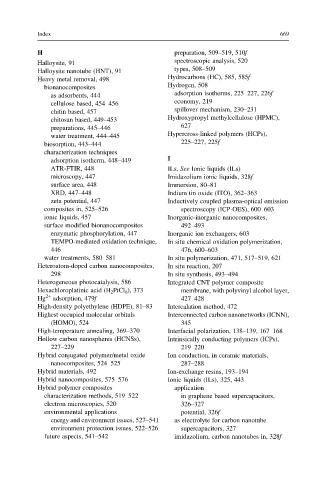Page 726 - Polymer-based Nanocomposites for Energy and Environmental Applications
P. 726
Index 669
H preparation, 509–519, 510f
Halloysite, 91 spectroscopic analysis, 520
Halloysite nanotube (HNT), 91 types, 508–509
Heavy metal removal, 498 Hydrocarbons (HC), 585, 585f
bionanocomposites Hydrogen, 508
as adsorbents, 444 adsorption isotherms, 225–227, 226f
cellulose based, 454–456 economy, 219
chitin based, 457 spillover mechanism, 230–231
chitosan based, 449–453 Hydroxypropyl methylcellulose (HPMC),
preparations, 445–446 627
water treatment, 444–445 Hypercross-linked polymers (HCPs),
biosorption, 443–444 225–227, 225f
characterization techniques
adsorption isotherm, 448–449 I
ATR-FTIR, 448 ILs. See Ionic liquids (ILs)
microscopy, 447 Imidazolium ionic liquids, 328f
surface area, 448 Immersion, 80–81
XRD, 447–448 Indium tin oxide (ITO), 362–363
zeta potential, 447 Inductively coupled plasma-optical emission
composites in, 525–526 spectroscopy (ICP-OES), 600–603
ionic liquids, 457 Inorganic-inorganic nanocomposites,
surface modified bionanocomposites 492–493
enzymatic phosphorylation, 447 Inorganic ion exchangers, 603
TEMPO-mediated oxidation technique, In situ chemical oxidation polymerization,
446 476, 600–603
water treatments, 580–581 In situ polymerization, 471, 517–519, 621
Heteroatom-doped carbon nanocomposites, In situ reaction, 207
298 In situ synthesis, 493–494
Heterogeneous photocatalysis, 586 Integrated CNT polymer composite
Hexachloroplatinic acid (H 2 PtCl 6 ), 373 membrane, with polyvinyl alcohol layer,
Hg 2+ adsorption, 479f 427–428
High-density polyethylene (HDPE), 81–83 Intercalation method, 472
Highest occupied molecular orbitals Interconnected carbon nanonetworks (ICNN),
(HOMO), 524 345
High-temperature annealing, 369–370 Interfacial polarization, 138–139, 167–168
Hollow carbon nanospheres (HCNSs), Intrinsically conducting polymers (ICPs),
227–229 219–220
Hybrid conjugated polymer/metal oxide Ion conduction, in ceramic materials,
nanocomposites, 524–525 287–288
Hybrid materials, 492 Ion-exchange resins, 193–194
Hybrid nanocomposites, 575–576 Ionic liquids (ILs), 325, 443
Hybrid polymer composites application
characterization methods, 519–522 in graphene based supercapacitors,
electron microscopies, 520 326–327
environmental applications potential, 326f
energy and environment issues, 527–541 as electrolyte for carbon nanotube
environment protection issues, 522–526 supercapacitors, 327
future aspects, 541–542 imidazolium, carbon nanotubes in, 328f

